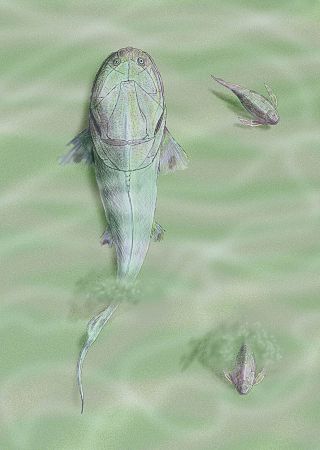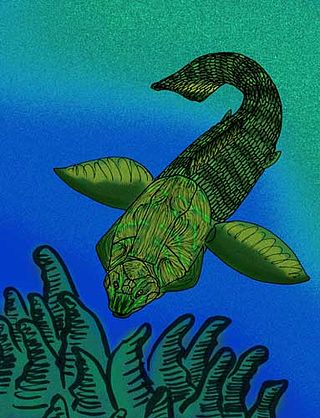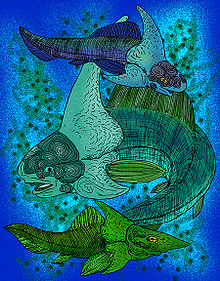
Placoderms are vertebrate animals of the class Placodermi, an extinct group of prehistoric fish known from Paleozoic fossils during the Silurian and the Devonian periods. While their endoskeletons are mainly cartilaginous, their head and thorax were covered by articulated armoured plates, and the rest of the body was scaled or naked depending on the species.

Bothriolepis was a widespread, abundant and diverse genus of antiarch placoderms that lived during the Middle to Late Devonian period of the Paleozoic Era. Historically, Bothriolepis resided in an array of paleo-environments spread across every paleocontinent, including near shore marine and freshwater settings. Most species of Bothriolepis were characterized as relatively small, benthic, freshwater detritivores, averaging around 30 centimetres (12 in) in length. However, the largest species, B. rex, had an estimated bodylength of 170 centimetres (67 in). Although expansive with over 60 species found worldwide, comparatively Bothriolepis is not unusually more diverse than most modern bottom dwelling species around today.

Drepanaspis is an extinct genus of heterostracan armoured jawless fish from the Early Devonian. Drepanaspis are assumed to have lived primarily in marine environments and is most commonly characterized by their ray-like, heavily armoured bodies, along with their lack of paired fins and jaws.

Groenlandaspis is an extinct genus of arthrodire from the Late Devonian. Fossils of the different species are found in late Devonian strata in all continents except eastern Asia. The generic name commemorates the fact that the first specimens of the type species were found in Greenland.

Rhenanida is an order of scaly placoderms. Unlike most other placoderms, the rhenanids' armor was made up of a mosaic of unfused scales and tubercles. The patterns and components of this "mosaic" correspond to the plates of armor in other, more advanced placoderms, suggesting that the ancestral placoderm had armor made of unfused components, as well.

The ptyctodontids ("folded-teeth") are placoderms of the order Ptyctodontida, containing the family Ptyctodontidae. With their big heads, big eyes, reduced armor and long bodies, the ptyctodontids bore a superficial resemblance to modern day chimaeras (Holocephali). Their armor was reduced to a pattern of small plates around the head and neck. Like the extinct and related acanthothoracids, and the living and unrelated holocephalians, most of the ptyctodontids are thought to have lived near the sea bottom and preyed on shellfish.

Weejasperaspididae is a family of three extinct acanthothoracid placoderms indigenous to the Early Devonian of Victoria and New South Wales, Australia.

Lunaspis is an extinct genus of armor-plated petalichthyid placoderm fish that lived in shallow marine environments of the Early Devonian period, from approximately 409.1 to 402.5 million year ago. Fossils have been found in Germany, China and Australia. There are three different identified species of within the genus Lunaspis: L. broilii, L. heroldi, and L. prumiensis.

Phyllolepis is the type genus of Phyllolepida, an extinct taxon of arthrodire placoderm fish from the middle to late Devonian. The species of Phyllolepis, themselves, are restricted to the Famennian-aged freshwater strata of the Late Devonian, around 360 million years ago. Fossils of this genus have been found primarily in Europe and North America. The end of the Devonian saw them disappear in a mass extinction.

Homosteus is a genus of flattened arthrodire placoderm from the Middle Devonian. Fossils are found primarily in Eifelian-epoch aged strata of Europe, Canada, Greenland, and Estonia. All of the species had comparatively large, flattened heads with, as suggested by the upward opening orbits, upward-pointing eyes. These adaptations suggest that the various species were benthic predators. A study on Titanichthys, in contrast, suggests that species of Homosteus may have been filter-feeders instead.

Holonema is an extinct genus of relatively large, barrel-shaped arthrodire placoderms that were found in oceans throughout the world from the Mid to Late Devonian, when the last species perished in the Frasnian-Fammian extinction event. Most species of the genus are known from fragments of their armor, but the Gogo Reef species, H. westolli, is known from whole, articulated specimens.

Holonematidae is an extinct family of relatively large arthrodire placoderms from the Early to Late Devonian. Almost all fossil specimens are of armor fragments, though, all have distinctive ornamentation, often of unique arrangements and patterns of tubercles, that are diagnostic of the family. The trunkshield is very elongated, giving the armor an overall "barrel" like appearance.

Yunnanolepididae is an extinct family of primitive Antiarch placoderms characterized by having short, broad skull roofs, and by having a feature on the visceral side of the posterior medial dorsal plate, the crista transversalis interna posterior, which is diagnostic of antiarchs, turning forward, and lying in front of the posterior ventral process and pit.

Aspidichthys is a genus of large, distinctively tuberculated arthrodire placoderm of uncertain affinities from Upper Devonian marine strata in the Eastern United States and Europe.

Weejasperaspis is an extinct acanthothoracid placoderm found in the Taemas-Weejasper Reef, of the Early Devonian-aged Buchan Group in eastern Victoria, Australia and the type species is W. gavini. Weejasperaspis differs from other acanthothoracids in that the median dorsal crest is short, and triangular-shaped. Its sister genus, Murrindalaspis, differs from it by having large, blade-like median dorsal crests that are recurved. Like Murrindalaspis, it is only known from a dorsal plate and ossified eyeballs.

Brachydeirus is a genus of small to moderately large-sized arthrodire placoderms from the Late Devonian of Europe, restricted to the Kellwasserkalk Fauna of Bad Wildungen and Adorf.

Oxyosteus is a genus of trout-sized, highly compressed arthrodire placoderms from the Late Devonian of Europe: The two described species are restricted to the Late Frasnian-aged Kellwasserkalk Fauna of Bad Wildungen, while a median dorsal plate of an unnamed species is known from the Middle Frasnian Holy Cross Mountains of Poland.
Microbrachius is an extinct genus of tiny, advanced antiarch placoderms closely related to the bothriolepids. Specimens range in age from the Lower Devonian Late Emsian Stage to the Middle Devonian Upper Givetian Stage. They are characterized by having large heads with short thoracic armor of an average length of 2–4 cm. There are patterns of small, but noticeable tubercles on the armor, with the arrangement varying from species to species. Specimens of Microbrachius have been found in Scotland, Belarus, Estonia, and China.

Asterolepis is an extinct genus of antiarch placoderms from the Devonian of North and South America and Europe. They were heavily armored flat-headed benthic detritivores with distinctive jointed limb-like pectoral fins and hollow spine. The armor plate gives the Asterolepis a box-like shape. Its pectoral fins are also armored but the caudal and dorsal fin are not. The first fossils were named by M. Eichwald in 1840 after noticing star-like markings on the fossils.

Kimbryanodus is a genus of extinct ptyctodontid placoderm fish from the Frasnian of Australia.These placoderms can be told apart from others due to the large eyes, crushing tooth plates, long bodies, reduced armor, and a superficial resemblance to holocephalid fish. The group is so far the only Placoderms known with sexually dimorphic features. The fossils occur as small three dimensional isolated plates. Because of these new specimens the Ptyctodontid grouping got a taxonomic classification, it found that the genus Rhamphodopsis to be the most basal taxa. They are divided by having the more basal taxa having a median dorsal spine, a simple spinal plate, and a simple V-shaped overlap of the anterior lateral and the anterior dorsolateral plates.



















